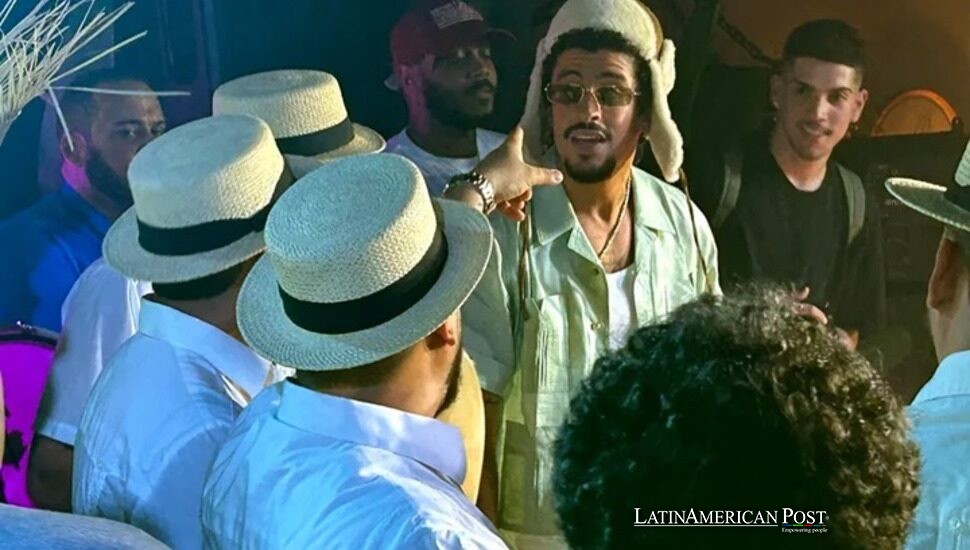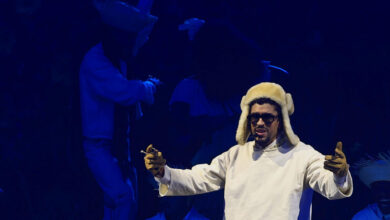Can Puerto Rican Stars Bad Bunny and Rauw Alejandro Jump Start a Salsa Resurgence?

In the past few weeks, two Puerto Rican megastars——have surprised fans by weaving old-school salsa influences into their music, fueling talk of a possible revival of the once-dominant Latin genre. Yet, while the hype is huge, can this high-profile trap and reggaetón artists kickstart a renaissance for salsa, a style that has slipped off the charts for years?
An Unlikely Path To Number One
For many observers, the album Debí Tirar Más Fotos by Bad Bunny has sparked new speculation about salsa’s future. Poised to hold the Billboard 200’s top spot for a third consecutive week, the project defies easy classification. While it primarily showcases trap, reggaetón, and other urban sounds, glimpses of plena, bomba, and yes—splashes of salsa—appear throughout its 17 tracks. According to Billboard, even a few “four-minute jam sessions” with horns and soneos have soared on charts previously dominated by trap bangers.
Critics and fans call this mixture a love letter to Puerto Rico’s expansive musical heritage. Indeed, the album’s opening track references El Gran Combo’s 1975 salsa classic “Un Verano en Nueva York” before pivoting to a modern reggaetón beat. Salsa fans get a thrill when a top streaming artist pays tribute to a classic tropical song. But this honor leads to a question: Do these nods help revive an idle music style?
The rise of “Debí Tirar Más Fotos” sparks interest in younger listeners. Teen fans who prefer reggaetón or trap now connect with plena’s lively beat and salsa’s bold brass sounds. That crossover potential has led to headlines describing it as “the album that might jumpstart salsa’s rebirth.” But those headlines often omit another figure: Rauw Alejandro, who last year made a bold move with Cosa Nuestra, an album that also utilized tropical references—especially salsa—and soared to No. 6 on the Billboard 200. The album’s name is a nod to Willie Colón and Héctor Lavoe’s 1969 masterpiece Cosa Nuestra, further cementing ties to the golden age of Puerto Rican salsa.
In an interview with Billboard, Rauw confessed that salsa is not his main style but lives in his blood and culture: “I love it, and I wanted to recapture that spirit.” Despite a primarily reggaetón identity, Rauw integrated live instrumentation and big-band flourishes. The results were immediate. Streams spiked, while fans praised the authenticity. Indeed, Cosa Nuestra might have foreshadowed Bad Bunny’s path with Debí Tirar Más Fotos, showing that star power plus thoughtful tributes to traditional forms can lure new generations.
However, a significant question remains: Can these two chart-topping icons truly unify their trap/reggaetón fans around salsa? After all, the music industry’s track record suggests it is often fleeting crossovers rather than deep transformations. Over decades, salsa has receded behind reggaetón’s unstoppable growth. Data from Luminate underscore how tropical subgenres remain the smallest slice of Latin music markets. Even with intermittent bursts—like Marc Anthony’s unstoppable ballads or Grupo Niche’s consistent presence—salsa stands overshadowed. Yet the synergy of Bad Bunny and Rauw championing it might shake up that equation.
How Two Superstars Honor Old Traditions
The narrative forming around these two leading Puerto Rican artists highlights how each merges personal style with island traditions. For Bad Bunny, the impetus stems from a desire to highlight local forms like plena and bomba. Though the global public mainly associates him with trap hits or reggaetón anthems, he teased these folk styles on earlier releases. But nowhere has he embraced them as comprehensively as on Debí Tirar Más Fotos, which Billboard calls a “multi-genre tapestry with strong tropical underpinnings.” The album remains anchored in urban sonics to keep his core fan base engaged.
Meanwhile, Rauw’s approach to Cosa Nuestra leaned heavier into salsa’s brass sections and live band dynamics. In earlier statements to Billboard, he explained that the name pays homage to Willie Colón’s revered 1969 record featuring Héctor Lavoe. Rauw referenced that era’s melodic lines, reimagined with modern percussion or rap breaks. He even performed with a live band for much of the album, capturing some of the immediacy that once made salsa a mainstay at dance halls. This approach resonated strongly, capturing the best debut chart position of Rauw’s career at the time.
While neither Cosa Nuestra nor Debí Tirar Más Fotos is pure salsa, both rely on it enough to hint that it is not a mere cameo. They reflect an emerging pattern: leading reggaetón or urban talents acknowledging that tropical rhythms shaped their communities. The question is whether, from this vantage, they can spur a wave that leads to fresh salsa recordings by up-and-coming acts. So far, mainstream playlists have not fully embraced this shift. On Billboard’s Tropical Albums chart, older compilations or greatest-hits packages still reign. The synergy from Rauw’s or Bad Bunny’s new releases might be of fresh interest to some, but it remains to be seen how many fans will pivot from a few “salsa cameo tracks” to entire salsa albums by other artists.
A Tale Of Charts And Cultural Pride
According to Billboard, “Baile inolvidable” from Debí Tirar Más Fotos soared near the top of multiple global charts, a remarkable feat for a track deeply rooted in live tropical instrumentation. Another track, “DTMF,” replaced typical reggaetón with a foundation of plena, climbing to No. 1 on the Global 200. Even the Hot Latin Songs chart placed “Baile inolvidable” near the top. For watchers of mainstream pop trends, it is surprising that a composition peppered with stones and horn lines would surpass more predictable trap or dem bow tracks.
Bad Bunny admitted to Billboard that he never foresaw a plena-laced jam outshining the album’s more urban singles, but the numbers do not lie. Some of his fans posted videos of themselves learning salsa steps or referencing local music schools. Meanwhile, Rauw’s experience with Cosa Nuestra spurred interest among younger fans who discovered Willie Colón’s back catalog for the first time, drawn in by Rauw’s fresh spin on a staple of Puerto Rican heritage. That synergy underscores how the phenomenon is less about a fleeting novelty and more about bridging old and new.
Yet, for all the excitement, a broader salsa revival still faces challenges. After Debí Tirar Más Fotos soared, Billboard indicated no primary wave of pure salsa albums entering top-tier charts. Instead, the hype revolves around a few tropical-inflected tracks dominating streams. The question becomes whether fans, teased by these fusions, dig deeper into the salsa archives or move on to the next ephemeral sound. Rauw acknowledges that bridging fans between anthemic reggaetón and full-blown salsa numbers is brutal. He told Billboard that he expected less mainstream success from the pure salsa cuts on Cosa Nuestra, so he balanced them with more typical urban structures.
One advantage is the star power behind these songs. Bad Bunny stands among the most streamed artists worldwide, so a single mention of salsa or a cameo from an iconic group can cause spikes in attention. His fans might dive further into tropical subgenres, especially if he keeps performing these pieces in large stadium shows. Although smaller, Rauw brings a similarly dedicated following that loves his romantic anthems and dance grooves. If both stay publicly championing salsa, they might legitimize it to an audience that historically saw it as their parents’ or grandparents’ music.
A Future Of Opportunity Or Passing Fad
So, can these two global powers truly reboot salsa for a new generation? On the one hand, the surface-level indicators look promising. Both men remain top-tier chart contenders, with the personal influence to direct the gaze of millions. Conversely, no single album cameo or short wave of new singles can fix deeper structural problems that have caused tropical subgenres to fade from the mainstream. The streaming era, so beneficial for reggaetón, has not been equally kind to old-school salsa. The typical length of salsa tracks, heavy reliance on large orchestras, and older fan base might hamper streaming metrics that emphasize quick gratification.
But experts note that the success of “Baile inolvidable” or Cosa Nuestra underscores one potential path: a “collaborative revival” where younger trap/reggaetón acts integrate more salsa elements while featuring cameo appearances by established salseros. This synergy might gradually reintroduce the heritage to younger fans. If that approach continues, it might yield fresh momentum for salseros like Luis Figueroa or Christian Alicea or lead to collabs with established legends who still command respect in the scene.
Rauw ventured that the genre could remain relevant even if these steps do not vault salsa back to its 1970s heyday. He told Billboard that the main goal is to keep salsa in the conversation, ensuring that each new generation recognizes it as part of Puerto Rico’s story. For him, it is less about dethroning reggaetón and more about adding diversity to the mainstream. Similarly, Bad Bunny’s approach is not an attempt to revert to older times but a statement of cultural pride—flaunting that Puerto Rico’s evolving identity includes street-savvy trap flows and the soul of tropical rhythms.
Such an outlook resonates with the track record of global trends. Traditional forms seldom reemerge precisely as they were; they often come back as fused shapes that resonate with modern tastes. Observers highlight prior episodes, like Celia Cruz’s “La negra tiene tumbao,” which boldly wove rap elements into a quintessential salsa structure. At the time, some purists scoffed, but that experiment helped keep Cruz relevant to younger audiences. If these new fusions by Rauw and Bunny achieve similar feats, a subset of fans might delve further, exploring entire catalogs from Willie Colón, Héctor Lavoe, or El Gran Combo.
Nonetheless, every wave has its crest and trough. If mainstream attention shifts to the next big novelty, the partial revival of salsa might fade. Thus, the objective measure might be whether smaller-scale salsa releases—like a new album from up-and-coming salseros—begin to chart on Billboard’s Tropical Albums list with an impact. Right now, that chart remains filled with older anthologies or beloved re-releases. The challenge is to persuade fans that not only can salsa coexist with trap, but it can also stand alone, vital, and contemporary.
Whether Bad Bunny and Rauw’s partnership catalyzes a “salsa renaissance” or ends up as a fleeting phenomenon rests in the hands of fans. The fact that their cross-genre tracks have soared in streams and spurred a wave of social media covers is undeniably good news for a subgenre once deemed unstoppable in the ’70s and ’80s, only to be sidelined in the 21st century by unstoppable dembow. The industry stands at a crossroads: if new artists see potential in mixing in salseros as they do reggaetoneros, and if fans reward these combos with ongoing listens, we could see an awakening.
Ultimately, the question remains: Are Rauw and Bunny enough to tip the scales? Possibly. They represent the pinnacle of global Latin stardom, each with a unique trajectory and a proven ability to break barriers. Their combined influence far exceeds that of typical niche experiments. The key is sustaining it. The wave must expand beyond cameo appearances and splashy chart debuts for fundamental transformation. Record labels, streaming curators, radio programmers, and fans must support new salsa-infused releases.
So, while a definitive “Yes, salsa is back” remains premature, the scene is more hopeful than it has been in years. Billboard coverage highlights the data: big, unusual songs with salsa flavor climbing mainstream charts, an appetite for nostalgic instrumentation, and an apparent willingness among top-tier artists to champion local musical traditions. From that vantage, Bad Bunny and Rauw Alejandro’s synergy might reshape the conversation. If they maintain the momentum, fresh salseros could find a receptive audience for truly modern interpretations of a beloved genre.
Also Read: Farewell to Mayra Gómez Kemp, Icon of Spanish Television
For now, the charts show undeniable curiosity. But as with all ephemeral waves, the next months will reveal whether that curiosity grows into sustained passion. For longtime salsa devotees, seeing these massive stars unearth the horns, rhythms, and songs of their island’s heritage is an energizing shift—one that hopefully signals the forging of a new era where salsa thrives once more among younger generations, carried forward by the biggest names in Puerto Rican music.





